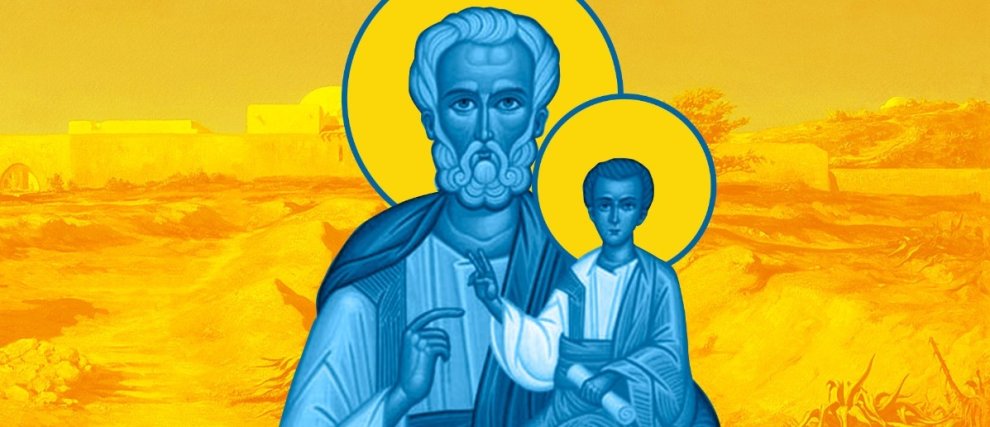Saint John
The Life of Saint John, Apostle and Evangelist
Saint John, not to be confused with Saint John the Baptist, is one of the twelve apostles of Jesus. Born in Bethsaida, Galilee, he is one of the sons of Zebedee, a fisherman on the lake of Tiberias. John was first one of the disciples of John the Baptist, until he introduced the Messiah to them: “the Lamb of God who takes away the sin of the world”. His brother James, called the Elder, was also chosen by Jesus to be part of the Twelve. In the Gospel, John and James are called the Sons of Thunder. Their mother, Salome, was one of the women disciples who accompanied Jesus and Mary during the three years of public life. She is spoken of in the gospel when she asks for her sons to be given places of honor in Heaven with Christ (Matthew 20:20-23).
Saint John, the youngest of the Twelve, is called Jesus' favorite disciple. Several scenes in the Gospel indicate that, like Mary Magdalene, John was the one who “choose the best part”, keeping company with Jesus and taking refuge on his heart: at the Last Supper, John rests his head on the Savior's chest, shortly afterwards he stands at the foot of the Cross. In some of his last words, Jesus unites him to his mother: “Woman, this is your son”, then addressing the disciple: “This is your mother”. John is both the one who loves Jesus the most and the one who was particularly cherished; he was “the disciple whom Jesus loved”. Together with the apostles Saint Peter and Saint James, John was part of the trio that Jesus chose in the great moments: the resurrection of the daughter of Jairus, the Transfiguration on the Thabor and Agony in the Garden of Olives. At the resurrection of Christ, John was the one who came first to the tomb saying of himself “he saw and believed,” though he humbly let Peter in first. Saint John is the author of the fourth gospel: the gospel according to Saint John, as well as the three letters of John and Revelations. John is the only one of the apostles who did not die a martyr. According to Saint Irenaeus and Saint Jerome, he lived long years after the death of Christ, as Jesus had foretold by this mysterious word: “If I want him to remain alive until I return, what is that to you? ”(Psalms 21: 22- 23). John lived long years in Ephesus with the Virgin Mary, imbued with the holiness of Mary. Finally exiled to the island of Patmos, the tireless apostle of the love of Christ died there at the age of 84. Shortly after his burial, his tomb was found empty and became a place of healing, every May 8th, a miraculous ash appeared.
Representations of the Evangelist John
In iconography, John the Evangelist is represented by the eagle, this symbol had its origin in the vision of the prophet Ezekiel. His attributes include: the book, which indicates the gospel of which he is the author, the vat of boiling oil, in memory of the miracle where, thrown into this vat, John emerged unharmed. The representations show him with a palm in his hand, which was given to him by the dying Virgin. Finally, Saint John is depicted with a cup with an emerging serpent. This is a reminder of the miracle in which John was saved from the effects of a deadly poison.
Saint John
When we speak of Saint John, we must distinguish between the celebrations of Saint John in summer from Saint John in winter. Thus, Christians have become accustomed to distinguishing the two feasts from each other. One is the feast of the Baptist and the other the feast of the Apostle and faithful friend of Jesus. Saint John the Baptist is celebrated on the night of June 23 to 24. On this occasion, a great bonfire is lit: the fire of Saint John. The feast of John the Apostle is celebrated on December 27.
Works of the Evangelist Saint John
Although modern exegetes are disputed, the entire Christian tradition up to the nineteenth century is unanimous and sees the Apostle John as the author of the gospel that bears his name. The John’s writings found in the Bible, in the New Testament, are characterized by a unity of style, themes and vocabulary.
The Gospel of Saint John
This gospel differs from the other three (Gospels of Matthew, Mark and Luke) in its spiritual height, it is called "the Flower of the Gospels" or "Gospel of the Logos" (the Word of God). This gospel is centered on the mystery of the incarnation of the Word and fully manifests the divinity of Christ.
The Letters of Saint John
There are three in number, probably written at Ephesus. With regard to love and faith, these letters reaffirm spiritual truths that are fundamental to confronting the attack of Gnostic doctrines.
The Apocalypse according to Saint John
The Book of Revelations is the book that closes the New Testament. This extraordinary book is revealed by visions to Saint John when he was already old and exiled on the island of Patmos. It is the only prophetic book of the New Testament. The original Greek word is “Apocalypse”, meaning, “revelation.” In fact, this book symbolically presents events to come or already happening at that time, in connection with the End of Time.
Praying with Saint John on Hozana
Saint John is the beloved apostle of the Lord. Let us look to him and follow in his footsteps thanks to these communities of prayer on Hozana:
- The path of holiness that Saint John points out to us is that of love. With him,
- Saint John is the one who rests on the Heart of Jesus. We too take refuge in the Sacred Heart of Jesus by .
- The evangelist John left the world a burning gospel to reveal Christ to us. and our lives will be renewed.

